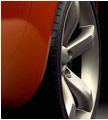GM/Energy Company Research Team Submits Initial
Study for European Conditions
The effect of various propulsion
systems and fuels on global warming potential analyzed
For Release: May 15, 2002
CONTACTS:
Scott Fosgard, GM Advanced Technology
Phone: 586.947.3295; 810.899.2582 (cell)
e-mail: scott.fosgard@gm.com
Johan Willems, General Director Product Communications and
Operations, GM Europe
41 1 828 2519; 41 79 605 6260 (cell)
e-mail: johan.willems@ch.gm.com
BRUSSELS, Belgium. - General Motors Corp. with input
from various energy com-panies and a leading independent
research institute, presented initial results today from
a comprehensive study assessing the effect of greenhouse
gas emissions at a leading fuels conference.
The study, released at the Hart World Fuel Conference,
assessed fuel sources, processing techniques and propulsion
systems. A total of 36 fuel pathways and 18 propulsion concepts
examined for the 2010 timeframe, from conventional engines
to advanced concepts, were analyzed under European driving
conditions. (The study assessed energy efficiency and greenhouse
gas emissions, but not costs.) Experts examined the complete
chain, from the production of fuels from their basic feedstock
components to the actual consumption of the fuel in the
car, what scientists call "well-to-wheel" analysis.
Ludwig Bolkow Systemtechnik (LBST), a research institute
in Ottobrunn, Germany (near Munich) acted as a scientific
advisor and consultant. BP, ExxonMobil, Shell and Total-FinaElf
energy companies provided additional data and analysis.
A principal finding of the study was that fuel cell vehicles
using hydrogen produced from natural gas could be attractive
in terms of well-to-wheel gas emission depending on the
source of the natural gas. However, optimum results are
realized when renewable energies such as biomass or wind
power are used to produce the hydrogen. (For purposes of
this study, biomass is fuel generated from trees, sugar
beets and oil seeds and did not include garbage.)
This project is a sequel to the North American Well-to-Wheels
study published by GM, BP, ExxonMobil, Shell and Argonne
National Labs last year analyzing the impact of energy sources
and alternative propulsion systems in North America. In
that study, a Chevrolet Silverado pickup was used as a reference
vehicle. That study reached similar conclusions and is now
regarded as a reference work in worldwide discussions on
transport-related greenhouse gas emissions and energy consumption.
In the new study, the original method-ology was applied
in a European context for both fuel and vehicle.
"We based our additional research work, which took
over a year, on the Opel Zafira minivan, European driving
conditions, and our understanding of the European energy
supply situation," explained Raj Choudhury, project
manager for the study at a GM research center in Mainz-Kastel,
Germany.
The vehicle data for the European study was compiled by
GM scientist, Trudy Weber:
"The Zafira proved to be the ideal reference vehicle,
since it already exists with gasoline, diesel, compressed
natural gas (CNG) and fuel cell propulsion systems. We forecasted
the powertrain system characteristics for the 2010 time
frame and imposed the con-straint that all 18 vehicle variants
examined be able to meet the same set of stringent, customer-based
performance criteria over the European drive cycle (EDC).
"For the first time, this provided us with a realistic
and comparable basis for energy use and net greenhouse gas
emissions in a European context," Weber said.
On the fuel side, a variety of different pathways were
considered. They can be put into four basic groups, based
on their source of feedstock: crude oil, natural gas, electricity
- from both traditional power stations and renewable sources
- and biomass.
Results to emerge from the study included:
"The best alternative, however, is to produce hydrogen
from renewably generated electricity - e.g. wind power -
and use it in a fuel cell. This will essentially eliminate
well-to-wheel greenhouse gas emissions," says Dr. Erhard
Schubert, Co-director of GM's Fuel Cell Activities.
The complete study will be concluded and published this
summer. The focus for the GM team now turns to addressing
commercialization challenges faced by fuel cell vehicles
and the hydrogen infrastructure, including cost and availability
issues.
"It's clear fuel cells have much more promise than
any other propulsion option, especially when if renewable
energy is used in the production of hydrogen as a suitable
infrastruc-ture becomes available," says GM Vice President
Larry Burns, responsible for research & development
and planning at General Motors. "That is why we intend
to do everything we can to produce a fuel cell car that
is both affordable for the customer and economically viable
for us by the end of this decade."
GM has more than 400 scientists and engineers working globally
on fuel cell propulsion systems and their commercialization
with research facilities in Honeoye Falls, NY; Mainz-Kastel,
Germany and Warren, Mich.




